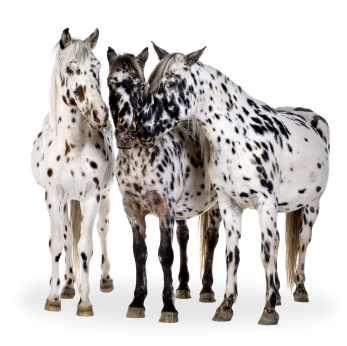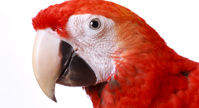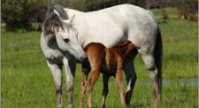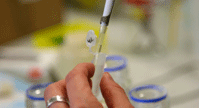Appaloosa Pattern-1 (PATN1)
Description:
 Leopard complex spotting (LP), the result of an incompletely dominant mutation in TRPM1. This produces a highly variable group of white spotting or depigmentation patterns in the horse. The LP mutation allows for the expression of the various patterns. In addition to LP other genes control the extent (or amount) of depigmented or white in areas.
Leopard complex spotting (LP), the result of an incompletely dominant mutation in TRPM1. This produces a highly variable group of white spotting or depigmentation patterns in the horse. The LP mutation allows for the expression of the various patterns. In addition to LP other genes control the extent (or amount) of depigmented or white in areas.
A mutation SNP ECA3:23 658 447T>G in the RFWD3 gene is linked to an increased amount of white in LP horses known as Pattern 1 (PATN1). When combined with LP this mutation behaves in a dominant fashion. This means that a horse needs a single copy of the PATN1 mutation to observe large amounts of white as long as LP is present. Horse that are PATN1 positive but negative for LP will not have spotting but can pass on PATN1. A foal can receive a PATN1 copy from a solid non-spotted parent and a copy of LP from the other parent and be a few-spot or near few spot pattern.
Studies have confirmed that the PATN1 mutation is present in many breeds including the Appaloosa, American Miniature Horse, British Spotted Pony and Knabstrupper, among others. Animal Genetics has found the PATN1 mutation in other horse breeds lacking LP thus not effecting the phenotype of the animal.
Test Results For PATN1:
Animal Genetics offers DNA testing for the RFWD3 gene mutation associated with (PATN1). The genetic test verifies the presence of the dominant (PATN1) mutation and presents results as one of the following:
| PATN1/PATN1 | Homozygous | Positive for dominant PATN1 mutation. Indicates the animal carries two inherited copies. Homozygous horses will pass the variant on to their offspring 100% of the time. |
| PATN1/n | Heterozygous | Positive for dominant PATN1 mutation, carrying a single inherited copy. Heterozygous horses will pass the variant on to their offspring 50% of the time. |
| n/n | Negative | Negative for PATN1. Will never pass variant on to their offspring. |
Test Results In Conjunction With LP:
| lp/lp | n/n | Non Appaloosa, will not pass on LP or PATN1 to offspring. |
| lp/LP | n/n | Heterozygous LP horses will pass the to 50% (blanket appaloosa). |
| LP/LP | n/n | Negative for PATN1 (snow cap appaloosa). |
| lp/lp | n/PATN1 | Non Appaloosa, will not pass on LP. Will pass on PATN1 50% of the time. |
| lp/LP | n/PATN1 | Produces a leopard or a near–leopard pattern. |
| LP/LP | n/PATN1 | Results in a few-spot or near few spot pattern. |
| lp/lp | PATN1/PATN1 | Non Appaloosa, will not pass on LP but always PATN1 to offspring. |
| lp/LP | PATN1/PATN1 | Produces a leopard or a near–leopard pattern. |
| LP/LP | PATN1/PATN1 | Results in a few-spot or near few spot pattern. |
Combination LP/PATN1 Test $40.00:
References:
Anim Genet. 2015 Nov. 16. doi: 10.1111/age.12375. Variant in the RFWD3 gene associated with PATN1, a modifier of leopard complex spotting. Holl HM1, Brooks SA1, Archer S2, Brown K3, Malvick J4, Penedo MC4, Bellone RR5.
Submit a Sample for Testing:
To submit a sample for testing please click on ORDER and download a sample submission form. Then follow the sample collection and submission instructions.
Cost per sample is $25.00. Please see our Equine Fee Schedule for all equine testing rates.










